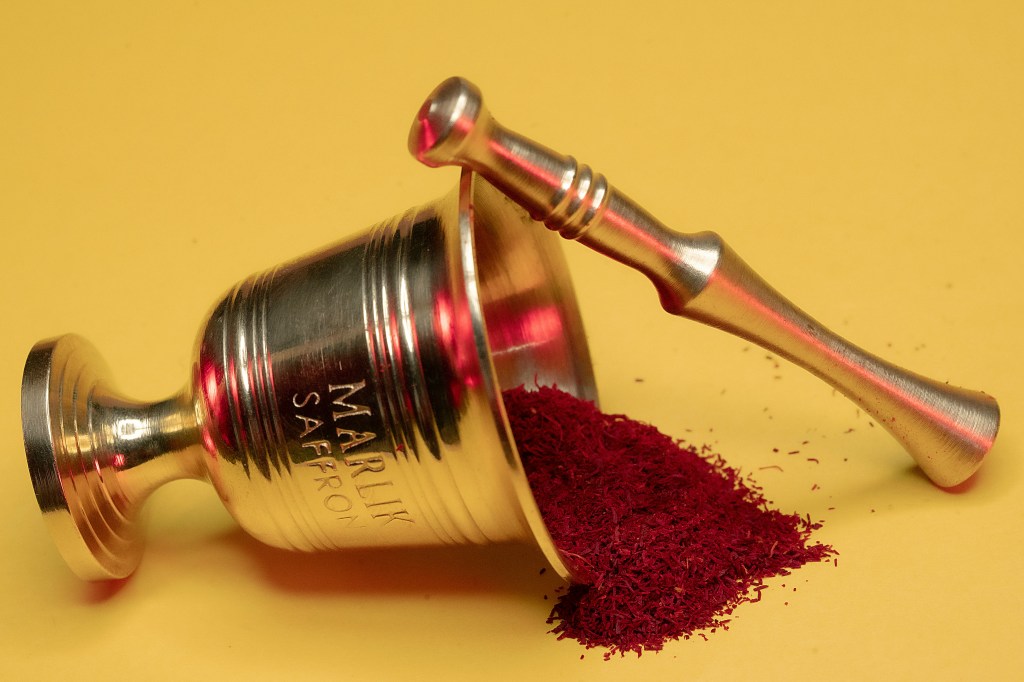The extraordinary story of saffron’s history, health benefits, and recipes

Image credit: Marlik saffron on Unsplash
Saffron—the most expensive spice in the world—is priced as gold, between $50-60 per gram for the Australian species, among 80 different varieties. Despite the price, the use in different cuisines is enjoyed, from Persian rice to chicken and potato dishes. In my personal opinion, I love the flavor in rice. I’ve tried it once, and I remember having it in my cupboard for a very long time.
Before we talk about recipes, or anything else. It’s a good start to delve into the origins, and history of this interesting spice. The origins are uncertain, but records show spice trade for centuries, dating back to Assyrian civilization during the 7th century BC. Other uses of saffron include religious rituals, cosmetics, and textiles during the bronze age and ancient Greece. An interesting fact, spice wars occurred due to this spice leading to the fall and rise of many cultures, making it the longest produced commodity till today.
The word saffron comes from the Persian word—Zaafaran—which means yellow flowers, or gold strung. Depending on your description, and eyesight. I’m not surprised with the name because when you dissolve one thread in water, it gives a red-yellowish, or golden color. The production is found all over the world from Asia, Europe, with 80-90% of production coming from Iran. The fascinating thing is that the only part used is the stigma, inside part, which makes up 7% of the flower. Lastly, the agricultural process is labor intensive for one gram.
Now, that we briefly talked about the origins and history. I’ll give some recipes that use saffron. I love Allrecipes, it gives a variety of different ingredients, cooking techniques, and tips. For example, if you’d like to add saffron to butter, they have one. In the mood for sweet instead of a savory dish, there is a delicious recipe for orange and saffron panettone.
The health and medical benefits of adding saffron to different dish is endless. One benefit might be emotional well-being in adults, the results suggest improved depression symptoms, and other mental disorders. Other health benefits, eye health, resistance to light damage, and effective against alzheimer disease. So, there might be benefit in treating several mood disorders, improvement in memory, but more research is needed to verify this. Though, this spice has also been used in traditional medicine, ancient times, and Ayruvedic medicine. On the other hand, there are several health benefits, which includes, antioxidant properties due to the presence of several compounds. There is a list of health benefits, listed here. This includes anti-inflammatory, anti-hypertensive, and cardiovascular benefits, among other “anti-” benefits. The compounds responsible for these health benefits provide the color, aroma, and flavor for the plant. Three carotenoids are found in saffron; I’m not going to bore you with the scientific names. Basically, the pigment is similar to the one in carrots, tomatoes, corn, and parsnips. Other pigments help with coloring the water, and recipes, while the oil composition is 70%. This provides the aroma, and antioxidant properties.
As you can see, saffron is an interesting spice, with variety of health benefits, versatile ingredient, and a long history with various cultures throughout the centuries. One thing to mention here, sustainable farming practices, organic farming, and fair trade initiatives are on the rise, which makes the agricultural practices of this spice no exceptions.
References
1. Jackson, P. A., Forster, J., Khan, J., Pouchieu, C., Dubreuil, S., et al (2021). Effects of saffron extract supplementation on mood, well-being, and response to a psychosocial stressor in healthy adults: a randomized, double-blind, parallel group, clinical trial. Front. Nutr. 7:606124. Website: https://www.frontiersin.org/articles/10.3389/fnut.2020.606124/full.
2. Maccarone, R., Di Marco, S., Bisti, S. (2008). Saffron supplement maintains morphology and function after exposure to damaging light in mammalian retina. Invest. Ophthalmol. Vis. Sci., 49(3):1254-1261. Website: https://doi.org/10.1167/iovs.07-0438.
3. Javed, S., Hanif, S., Aftab, A., Yousaf, Z., Moga, M. (2023). In: Zia-Ul-Haq, M., Abdulkreem AL-Huqail, A., Riaz, M., Farooq Gohar, U. (eds). Saffron. Essentials of medicinal and aromatic crops. Springer, 1083-1113. Website: https://doi.org/10.1007/978-3-031-35403-8_42.
4. Khazdair, M. R., Boskabady, M. H., Hosseini, M., Rezaee, R., Tsatsakis, A. M. (2015). The effects of crocus sativus (saffron) and its constituents on nervous system: A review. Avicenna journal of phytomedicine, 5(5): 376–391. Website: https://www.ncbi.nlm.nih.gov/pmc/articles/PMC4599112/.
5. Husaini, A. M., Haq, S. A. U., & Jiménez, A. J. L. (2022). Understanding saffron biology using omics- and bioinformatics tools: stepping towards a better Crocus phenome. Molecular biology reports, 49(6): 5325–5340. Website: https://doi.org/10.1007/s11033-021-07053-x.
6. Maxabella, Bron (2020). Saffron is worth its weight in gold – here’s why. SBS Food. Website: https://www.sbs.com.au/food/article/saffron-is-worth-its-weight-in-gold-heres-why/lamv19txp.
7. Saffron. Wikipedia. Website: https://en.wikipedia.org/wiki/Saffron.
8. The history of saffron. Sativus. Website: https://www.sativus.com/en/saffron/history/.
9. Allrecipes. Website: https://www.allrecipes.com/search?q=saffron+.

Pingback: Food science topics – Alimentative